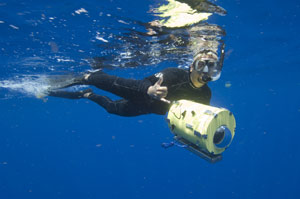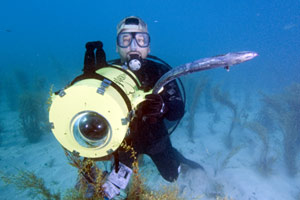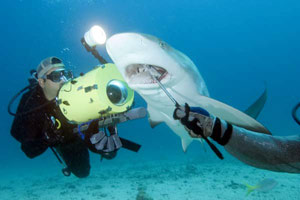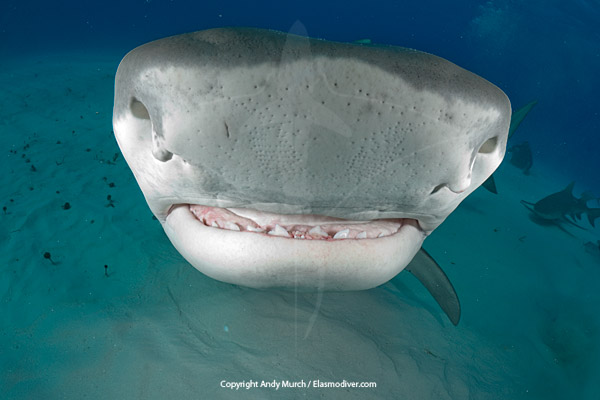There are rare occasions when
for no apparent reason a shark will persistently make close passes to the
delight of underwater photographers. More commonly however, getting near
enough to a shark to get a crisp shot with some nice skin tones in it is
an exercise in frustration unless you have some kind of attractant. Chum
is the obvious stimulus to encourage the sharks into the general area but
sometimes even when there is bait in the water, the sharks refuse to
approach the photographers, preferring to skulk at the edge of visibility
until the divers leave. You can't blame the sharks for this, they are
naturally cautious creatures and you don't reach the top of the food chain
by taking unnecessary risks. If you're patient and calm the sharks will
sense it and feeling less threatened they will most likely come closer. If
you're nervous and jumpy you probably shouldn't be trying to get closer in
the first place.
Bubble-phobic Sharks
 Picture
this; you're positioned unobtrusively behind a coral head. A large Tiger
Shark is nonchalantly ambling towards you looking like a striped reef god.
Its muscles ripple as it slips between some fan corals in its path. It is
almost within range of your strobes. Your lungs begin to burn and unable
to hold your breath any longer, you exhale a short burst of bubbles and
watch in anguished silence as the shark turns on a dime and bolts for the
liquid horizon. Perhaps its the unexpected movement or maybe its the
intensity of the noise but for some reason sharks hate bubbles. Whether
you're diving with Whale Sharks or Wobbegongs, breathing hinders
successful photography.
Picture
this; you're positioned unobtrusively behind a coral head. A large Tiger
Shark is nonchalantly ambling towards you looking like a striped reef god.
Its muscles ripple as it slips between some fan corals in its path. It is
almost within range of your strobes. Your lungs begin to burn and unable
to hold your breath any longer, you exhale a short burst of bubbles and
watch in anguished silence as the shark turns on a dime and bolts for the
liquid horizon. Perhaps its the unexpected movement or maybe its the
intensity of the noise but for some reason sharks hate bubbles. Whether
you're diving with Whale Sharks or Wobbegongs, breathing hinders
successful photography.
New divers are told to breathe
continuously while under water. This is good advice but sooner or later
most divers get to the stage where they are comfortable holding their
breath for short periods in order to avoid spooking marine life.
Photographers become masters at timing their breathing but there are ways
to avoid this issue completely.
The low tech answer is to learn
to free dive. There is more to free diving than simply seeing how deep you
can fall without your lungs imploding. I have seen some incredible shark
footage that I would not have thought possible until I found out that it
was captured by free divers. The key is to weight yourself correctly and
stay calm. Being able to slip under the waves for two or three minutes at
a time in the company of sharks can result in some great encounters but
there are drawbacks and dangers. If like me you are not an expert, you will
spend most of your time snorkeling at the surface which attracts the kind
of shark attention that you don't need. Also, free divers are prone to
shallow water oxygen blackouts caused by oxygen starvation and the build
up of C02. Never free dive alone and consider taking some lessons from a
qualified free diver.
The high tech answer is to dive
using a rebreather unit that recycles each breath scrubbing away the C02
and injecting new oxygen as required. On a recent trip to North Carolina I
took along my Buddy Inspiration Rebreather and I was glad that I did.
While the other divers were on the wreck the Sandtiger Sharks refused to
come close but as soon as the bubble blowers left I was inspected by
numerous curious sharks resulting in some great images. Rebreathers are
expensive toys but if you are serious about your shark photography you
wont be disappointed.
You
are what you wear
Shark Diving 101 looks at the
safety precautions that you can take when entering the water with sharks.
One of the key elements to avoiding exploratory bites is to wear dive gear
that is neither bright nor reflective. By toning down your diving
wardrobe, you will theoretically be left alone by the sharks and
ultimately have a more enjoyable and rewarding experience (jeez, I sound
like a PADI Instructor). That's all well and good for spectators at a feed but
from a photography stand point distance is usually the enemy.
To get around this, some
photographers break with convention and purposely wear neon gear that they
hope the sharks will take an interest in. If you're prepared to go to this
extreme to get close, then at least be sensible about which aspects of
your kit you decide to brighten up. Wearing a loud wetsuit probably makes
you more interesting to some sharks even if it scares the heck out of the
other divers. Wearing white gloves against a black suit says "attack my
hands - they're wounded fish". It's your call but after photographing
sharks for some time now, I am happy to patiently wait for a lucky shot
while
sporting my black wetsuit, with my black gloves on, and my custom black
painted Aquatica camera housing in hand - you get the picture. The only
compromise that I make is that I wear bright fins. I don't mind if they get
bitten in half as long as they don't choke a shark in the process
I know of one videographer who
has pushed this concept way beyond the bounds of sanity. He attaches old
compact discs to his chest and shoulders to recreate the flickering
patterns emitted by a school of fish. The fact that he does not move as
fluidly as a school of healthy fish, adds to the attention this elicits.
Thrash
Using jerky body movements is a
double edged sword. If the sharks are getting worked up it will probably
peek their interest but if they are already acting timidly it will more
likely scare them away.
Become
one with the bait
 If carrying the
bait around with you doesn't seem like the smartest thing to do, don't do
it!
If carrying the
bait around with you doesn't seem like the smartest thing to do, don't do
it!
There is no denying that you
will become the centre of attention but at what cost? Sooner or later a
shark is going to pluck up the courage to make a dash at the bait and when
it does, it might not simply be a matter of dropping the fish and swimming
away. Other sharks may also get involved and if they get worked up enough
you could easily get caught in the middle of a feeding frenzy.
I have put fish in my BC
pockets, waved a carcass around, and spent the whole dive sitting on a
bait crate without getting bitten but that doesn't mean that it is a wise
activity. The sharks may only be after the food but when their eyes are
shut and they are being jostled by other sharks they will have a hard time
telling where the fish stops and your arm starts.
Talk
to the feeder

If you are attending a well
organized shark feed where there is a feeder or dive master who hand feeds
the sharks, it may be possible to arrange to have him or her lead the
sharks past you in such a way that you can get some very close feeding
shots.
Sometimes this is standard
protocol when photographers are present and sometimes it requires a little
persuading to convince the feeder that you are comfortable enough around
sharks to act responsibly.
Remember that if the DM says no
you should respect their decision. Usually there is a good reason e.g. it
may be much harder to control the feed when divers are in positions that
the resident sharks are not used to.
If you can arrange for this to
happen, don't waste the opportunity. Get as low as possible (usually
divers are overweighted on shark feeds to keep them in position) and shoot
a variety of compositions, some with the feeder in the shot and some with
just the sharks. Generally the wider and closer you can shoot the more
dramatic the shots will look.
Bottling
Bottling is a technique that
some divers tell me they use to great effect to entice sharks to come and
check them out. Personally, I have never been able to get it to work so
maybe I'm doing it wrong but here is the technique as I understand it.
Take a bottle along on the dive
hidden inside your bc. The best type would be a small ribbed plastic
bottle e.g. a disposable 750ml water bottle. Discreetly take out the
bottle and roll it between your palms with enough force to make it
crackle. The resulting noise is supposed to mimic the sound of fish bones
as they are being crunched between a sharks teeth. Before the sharks
(theoretically) arrive from all directions to investigate, hide the bottle
again so that they don't catch on. You may need to get the pitch right by
letting some water into the bottle.
I like this system for a few
reasons. Firstly, it doesn't involve killing and fish for bait. Secondly,
you're not actually feeding the sharks so there is no reason to think you
are changing their behavior. And thirdly, you can carry a bottle with you
just about anywhere. Its a shame I can't get it to work.
In a
nutshell:
Photographing sharks is
fundamentally the same as photographing anything else underwater. A
submersible camera and a means of breathing are all that you really need.
Having said that, there are a number of things you can do before you go
shark diving to improve your chances of getting the shot but remember the
warning about getting too close to the action!
-
Avoid bubbles - use a snorkel
or a rebreather
-
Wear brighter gear - but
remember why they call it yum yum yellow.
-
Carry some bait - this is
asking for trouble
-
Photograph the parade - Get the
feeder to lead the sharks to you
-
Try bottling - sounds like a
fish being eaten but doesn't always work


 Picture
this; you're positioned unobtrusively behind a coral head. A large Tiger
Shark is nonchalantly ambling towards you looking like a striped reef god.
Its muscles ripple as it slips between some fan corals in its path. It is
almost within range of your strobes. Your lungs begin to burn and unable
to hold your breath any longer, you exhale a short burst of bubbles and
watch in anguished silence as the shark turns on a dime and bolts for the
liquid horizon. Perhaps its the unexpected movement or maybe its the
intensity of the noise but for some reason sharks hate bubbles. Whether
you're diving with Whale Sharks or Wobbegongs, breathing hinders
successful photography.
Picture
this; you're positioned unobtrusively behind a coral head. A large Tiger
Shark is nonchalantly ambling towards you looking like a striped reef god.
Its muscles ripple as it slips between some fan corals in its path. It is
almost within range of your strobes. Your lungs begin to burn and unable
to hold your breath any longer, you exhale a short burst of bubbles and
watch in anguished silence as the shark turns on a dime and bolts for the
liquid horizon. Perhaps its the unexpected movement or maybe its the
intensity of the noise but for some reason sharks hate bubbles. Whether
you're diving with Whale Sharks or Wobbegongs, breathing hinders
successful photography. If carrying the
bait around with you doesn't seem like the smartest thing to do, don't do
it!
If carrying the
bait around with you doesn't seem like the smartest thing to do, don't do
it!




















